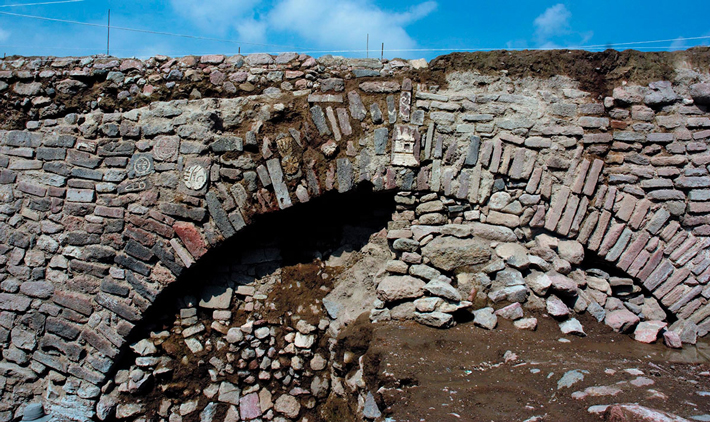Seventeenth-Century Tunnel in Mexico Preserves Pre-Contact Artwork
 ECATEPEC, MEXICO—Mexico News Daily reports that archaeologists from Mexico’s National Institute of Anthropology and History have discovered 11 images built into the walls of a 27-foot-long tunnel dating to the seventeenth century. The tunnel is part of a 2.5-mile-long network of dikes first constructed in the fifteenth century by Moctezuma I to regulate the flow of water into Mexico City, which was built on an island in the center of an inland lake system. The dike was destroyed by Spanish conquistador Hernán Cortés, and later rebuilt to control flooding. Archaeologist Raúl García said the images in the tunnel include a war shield, the head of a bird of prey, and a paper ornament. A picture of a temple, or teocalli, dedicated to the rain god Tlaloc, was etched into the central stone in the arch at the entrance to the tunnel. García suggests the petroglyphs and stucco relief panels could have been carved by people who lived in the nearby towns of Ecatepec and Chiconautla before the arrival of the Spanish and were later incorporated into the tunnel by people from the towns who worked on the rebuild. Four iron nails, two wooden beams, and a pile of organic material found in the tunnel may have been part of a gate to the seventeenth-century dike, García added. To read about the remains of the Aztecs' buried capital city, go to "Under Mexico City."
ECATEPEC, MEXICO—Mexico News Daily reports that archaeologists from Mexico’s National Institute of Anthropology and History have discovered 11 images built into the walls of a 27-foot-long tunnel dating to the seventeenth century. The tunnel is part of a 2.5-mile-long network of dikes first constructed in the fifteenth century by Moctezuma I to regulate the flow of water into Mexico City, which was built on an island in the center of an inland lake system. The dike was destroyed by Spanish conquistador Hernán Cortés, and later rebuilt to control flooding. Archaeologist Raúl García said the images in the tunnel include a war shield, the head of a bird of prey, and a paper ornament. A picture of a temple, or teocalli, dedicated to the rain god Tlaloc, was etched into the central stone in the arch at the entrance to the tunnel. García suggests the petroglyphs and stucco relief panels could have been carved by people who lived in the nearby towns of Ecatepec and Chiconautla before the arrival of the Spanish and were later incorporated into the tunnel by people from the towns who worked on the rebuild. Four iron nails, two wooden beams, and a pile of organic material found in the tunnel may have been part of a gate to the seventeenth-century dike, García added. To read about the remains of the Aztecs' buried capital city, go to "Under Mexico City."
from Hacker News https://ift.tt/33YaGEF